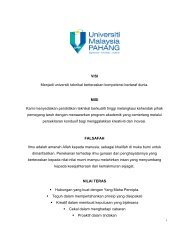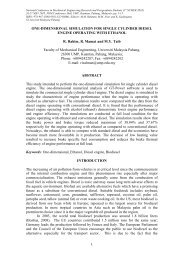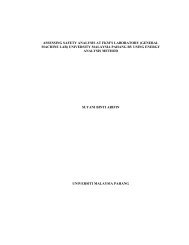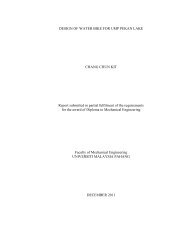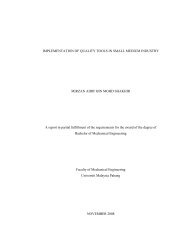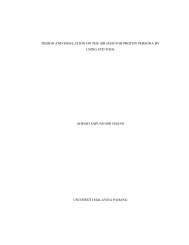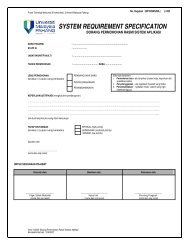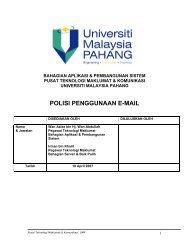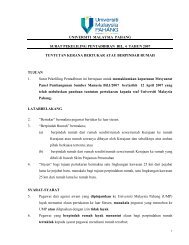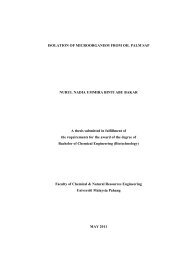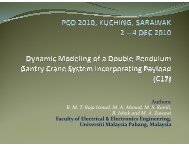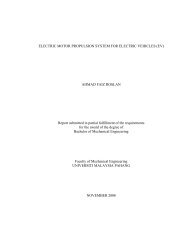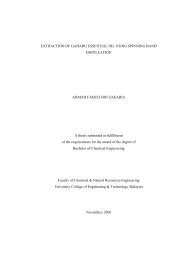EFFECT OF NOZZLE ANGLE ON JET IMPINGEMENT COOLING ...
EFFECT OF NOZZLE ANGLE ON JET IMPINGEMENT COOLING ...
EFFECT OF NOZZLE ANGLE ON JET IMPINGEMENT COOLING ...
You also want an ePaper? Increase the reach of your titles
YUMPU automatically turns print PDFs into web optimized ePapers that Google loves.
<strong>EFFECT</strong> <strong>OF</strong> <strong>NOZZLE</strong> <strong>ANGLE</strong> <strong>ON</strong> <strong>JET</strong> <strong>IMPINGEMENT</strong><strong>COOLING</strong> SYSTEMKHAIDER BIN ABU BAKARReport submitted in fulfilment of the requirementsfor the award of the degree ofBachelor of Mechanical EngineeringFaculty of Mechanical EngineeringUNIVERSITI MALAYSIA PAHANGNOVEMBER 2009
iiiSTUDENT’S DECLARATI<strong>ON</strong>I hereby declare that the work in this project is my own except for quotations andsummaries which have been duly acknowledged. The project has not been accepted forany degree and is not concurently submitted for award of other degree.SignatureName: KHAIDER BIN ABU BAKARID Number: MA 06053Date: 23 NOVEMBER 2009
Dedicate to my beloved dad, lovely mom and my honour siblingsiv
vACKNOWLEDGEMENTSFirst and foremost, grateful to Allah SWT for making it possible for me tocomplete this project on time. It is pleasure to acknowledge the help and support ofeveryone concerned with this project. To my father, mother and brothers who have beenso keen in helping and encouraging me during the several months it took me tocomplete this thesis.I would like to thank and express my deepest appreciation to my supervisor, Mr.Wan Azmi bin Wan Hamzah for providing me opportunity for his helpful reviews,comments and suggestion during the progression of this project. . I am truly grateful forhis progressive vision about my training in science, his tolerance of my naive mistakes,and his commitment to my future career. I also sincerely thanks for the time spent proofreading and correcting my many mistakes.Finally, my sincere thanks go to all my labmates Mr. Mohammad Khyru binAris, Mr.Dulfharah Nizam bin Memth Ali, members of the staff of the MechanicalEngineering Department, UMP : Mr. Mohammad Khalid bin Wahid, Mr. Nizam BinAbdullah, Mdm. Noor Sa’adah binti Nor Azmi, and members of the laboratory staffChemical Engineering Deparment,UMP, for the cooperation.
viABSTRACTCooling system using jet impingement is already widely used in industries nowadays.There were various approaches that have been investigated in order to produce moreefficient jet impingement cooling system. This thesis is study about the effect of thenozzle angle on jet impingement in order to identify the relationship in heat transfer.Besides, investigation on spacing distance between nozzle’s edge to the impingementsurface and Reynolds number at certain angle also identified in this study. Those studiesare needed parallel to the current researchers endeavor for future development ofcooling system in global industries. The experiment were perform by vary 3 majorparameters such as angle of the nozzle (30⁰, 45⁰, 60⁰, and 90⁰), distance betweennozzle’s edge to the impinge surface (H/d= 2, 4, 6, and 8) and also Reynolds number(Re= 2300, 1960,930 and 500).The heat source are heated at 100 ⁰C and cooled downby the flow of air from the nozzle. The heat source temperature after cooling aremeasured and collected. The result discovers about the relationship nozzle angle for jetimpingement cooling system which is heat transfer are more efficient when the angle ofnozzle approaching to the normal line as the Nusselt Number are more higher at 90⁰ inrange 31.5 w/m 2 K of heat transfer coefficient compare to the lower angles of the nozzle.Furthermore, higher Reynolds number and close range of distance between nozzle’sedges to impingement surface will also gives high Nusselt number which means bothalso effective cooling effects for the systems.
viiABSTRAKSistem penyejukan dengan menggunakan system penyejukan hentaman jet merupakanbidang yang luas dalam perindustrian pada masa kini. Pelbagai pendekatan daneksplorasi untuk menghasilkan sistem penyejukan jet hentaman ini. Tesis mengkajikesan sudut bagi muncung jet hentaman dalam proses pemindahan haba pada sesebuahsistem. Selain dari itu,penelitian terhadap perubahan pada halaju udara yang digunakansebagai medium penyejukan dan juga jarak antara hujung muncung jet hentaman ke ataspermukaan hentaman pada sudut tertentu terhadap sistem penyejukan juga dikenal pastidalam kajian ini. Kajian tentang hubung kait tersebut pada system penyejukan inisebenarnya amat diperlukan selaras dengan usaha para pengkaji seluruh dunia giatberusaha dalam memajukan system penyejukan untuk industri global masa hadapan.Eksperimen yang dijalankan akan mengubah 3 parameter utama iaitu sudut muncungjet hentaman (30⁰, 45⁰, 60⁰, and 90⁰), nombor Reynold (Re= 2300, 1960,930 and 500),dan juga jarak antara muncung jet ke atas permukaan hentaman(H/d= 2, 4, 6, and 8).Spesimen dipanaskan pada suhu 100 ⁰C dan disejukan oleh pengaliran udara yg dibawaoleh muncung jet. Suhu spesimen selepas penyejukan tersebut akan diambil dandikumpulkan. Apa yang diperolehi dalam eksperimen tersebut adalah hubungkaitpemindahan haba apabila sudut bagi muncung jet hentaman berubah di mana kadarpemindahan haba dijangkakan tinggi apabila sudut muncung jet hentaman mendekatigarisan normal dan ini jelas ditunjukkan pada nilai nombor Nusselt yang tinggi padasudut 90⁰ iaitu pada julat 31.5 w/m 2 K pekali kadar pemindahan haba berbanding dengansudut yang jauh lebih rendah.Selain dari itu, nombor Reynold yang tinggi dan jugajarak antara hujung muncung jet hentaman ke atas permukaan hentaman yang rendahakan menghasilkan nombor Nusselt yang tinggi dan ini membuktikan kedua-dua faktoritu juga faktor yang berkesan dalam sistem pemindahan haba.
viiiTABLE <strong>OF</strong> C<strong>ON</strong>TENTSSUPERVISOR’S DECLARATI<strong>ON</strong>STUDENT’S DECLARATI<strong>ON</strong>ACKNOWLEDGEMENTSABSTRACTABSTRAKTABLE <strong>OF</strong> C<strong>ON</strong>TENTSLIST <strong>OF</strong> TABLESLIST <strong>OF</strong> FIGURESLIST <strong>OF</strong> SYMBOLSLIST <strong>OF</strong> ABBREVIATI<strong>ON</strong>SPageiiiiivviviiviiixixiixivxviCHAPTER 1INTRODUCTI<strong>ON</strong>1.1 Background of Study 11.3 Problem Statement 21.3 Objectives of Study 21.4 Scopes of Study 2CHAPTER 2LITERATURE REVIEW2.1 Jet Impingement 42.2 Nozzle 52.32.42.52.62.72.8Convection Heat TransferLaminar FlowReynolds NumberNusselt NumberSteady StateHumidity6789910
ix2.9 Previous Research 12CHAPTER 3RESEARCH METHODOLOGY3.0 Introduction 153.13.23.3Flow ChartApparatusExperiment Setup1618203.3.1 Retort Stand scale Labelling 213.3.2 Labelling Specimen3.3.3 Angle Setup22233.4 Procedures 243.5 Data Distribution 273.6 Experiment Process Flow 29CHAPTER 4RESULTS AND DISCUSSI<strong>ON</strong>4.1 Introduction 314.24.3CalculationTables And Graph31334.3.1 At Constant Reynolds Number at Various H/d 334.3.2 At Constant H/d at Various Reynolds Number 384.4 Angle Distribution 424.5 Reynolds Number Distribution 444.6 H/d Distribution 45CHAPTER 5C<strong>ON</strong>CLUSI<strong>ON</strong> AND RECOMMENDATI<strong>ON</strong>S5.1 Conclusions 465.2 Recommendations 46
xREFERENCES 48APPENDICESA Table A-15 49B Data from Experiment 50CDGraph Temperature ( ⁰C ) vs r/dGraph heat transfer coefficient vs r/d5967
xiLIST <strong>OF</strong> TABLESTable No. Title Page2.1 List types of nozzle 53.1 List of the equipment typically required for the experiment 183.2 Data distributions for experiment 273.2 Continued 283.3 Sample of result table 294.1 Data configuration for Re=2300,H/d=2 344.2 Data configuration for Re=2300,H/d=4 354.3 Data configuration for Re=2300,H/d=6 364.4 Data configuration for Re=2300,H/d=8 374.5 Data configuration for Re=2300,H/d=2 384.6 Data configuration for Re=1960,H/d=2 394.7 Data configuration for Re=930,H/d=2 404.8 Data configuration for Re=500,H/d=2 41
xiiLIST <strong>OF</strong> FIGURESFigure No. Title Page2.1 Example one of jet impingement 52.2 Comparison on forced convection, natural convection and 7Conduction2.3 Temperature and relative humidity range in Malaysia 122.4 Graphs of obliquely impinging jet mean,Nusselt Number 13distributions, Re=10 0002.5 Graphs of obliquely impinging jet mean,Nusselt Number 13distributions, Angle 45⁰2.6 Graphs of obliquely impinging jet mean,Nusselt Number 14distributions, Re=10 000,Angle= 45⁰3.1 The flow diagram of the project 163.2 The flow diagram of the experiment 173.3 Anemometer 193.4 Laser Thermometer 193.5 Air regulator 193.6 Air Pipe 193.7 Heater 193.8 Steel Plate 193.9 Experiment Setup 203.10 Experiment setup for labelling height, Y scale at retort stand bar 21(side view)3.11 Labelling specimen 223.12 3-D view for angles setup by using Theorem Pythagoras 233.13 Actual experiment setup 25
xiii3.14 Steel Plate heated at 100 ⁰C 263.15 Angle setup for 45⁰, H/d= 6,Height Y= 4.3 cm and X= 4.3 cm 263.16 Experimental process flow 304.1 Graph Nusselt Number vs r/d at Re= 2300, H/d= 2 344.2 Graph Nusselt Number vs r/d at Re= 2300, H/d= 4 354.3 Graph Nusselt Number vs r/d at Re= 2300, H/d= 6 364.4 Graph Nusselt Number vs r/d at Re= 2300, H/d= 8 374.5 Graph Nusselt Number vs r/d at Re= 2300, H/d= 2 384.6 Graph Nusselt Number vs r/d at Re= 1960, H/d= 2 394.7 Graph Nusselt Number vs r/d at Re= 930, H/d= 2 404.8 Graph Nusselt Number vs r/d at Re= 500, H/d= 2 414.9 Graph Plate Temperature vs r/d at Re= 2300, H/d= 2 424.10 Graph Nusselt Number vs r/d at Re= 2300, H/d= 2 434.11 Graph Nusselt Number vs r/d at Angle 90⁰, H/d= 2 444.12 Graph Nusselt Number vs r/d at Re= 2300, Angle 90⁰ 45
xivLIST <strong>OF</strong> SYMBOLSReQ H / dr / dhNuC⁰Ddr cL cT sT ∞TkcpReynolds NumberRate of net heat transferDimensionless jet to heat source spacing to theDimensionless radius of the heat source areaHeat transfer coefficientNusselt NumberDegree CelciusDegreeDiameter of the wallDiameter of the nozzleRadius of the nozzleCharacteristic LengthTemperature surfaceAmbient temperatureTemperature DifferentThermal conductivitySpecific heatµ Dynamic viscosityVρυmFluid velocityDensityKinematic viscosityMolar mass
xvmA cA sMass flow rateArea of the nozzleArea of the wall
xviLIST <strong>OF</strong> ABBREVIATI<strong>ON</strong>SFYP Final year projectvs Versus3-D Three Dimension
CHAPTER 1INTRODUCTI<strong>ON</strong>1.1 BACKGROUND <strong>OF</strong> STUDYAir jets have been widely used in many industrial applications in order toachieve enhanced coefficients for convective heating, cooling or drying. A single air jetor arrays of air jet, impinging normally on a surface are an effective method to enhanceheat and mass transfer. High convective heat transfer coefficient is a very importantfactor that leads to the many usage of impingement jets in industrial for heating andcooling purposes. Jet impingement is an attractive cooling mechanism due to thecapability of achieving large heat transfer rates. This cooling method has been used inindustrial applications such as annealing of metals, tempering of glass, cooling of gasturbine blades, cooling in grinding processes and cooling of photovoltaic cells. Jetimpingement has also used for high-powered electronic and photonic thermalmanagement solutions and numerous jet impingement studies have been aimed directlyat electronics cooling.Due to the many industrial applications of impinging jets research has beenconducted to understand their flow and heat transfer characteristics. The main variablesfor jet impingement heat transfer are the angle of impingement, the jet Reynolds numberand the height of the nozzle above impingement surface. Convective heat transfer to animpinging air jet is known to yield high local and area averaged heat transfercoefficients. The research is concerned with the measurement of heat transfer toimpinging air jets over a wide range of test parameters. These include Reynoldsnumbers, Re, nozzle to impingement surface distance, H\d, and angle of impingement,from 30° to 90°.
21.2 PROBLEM STATEMENTThere are problems statements that have been defined in conjunction of thisproject. For convenience, the problems are determined and discover. Firstly, someapplication will use an effective method for their product such as for electronic coolingsystem. The study of effect of nozzle angle for jet impingement cooling system needed.The current method of heat removal, involving extended surfaces and fan arrays,frequently used in electronics is clearly insufficient, especially as the electroniccomponents become more and more powerful, dissipating more heat, whereas the spacearound these components continues to be reduced due to miniaturization trends.Furthermore, there are some relevant results we need to compare in order to state thebest effects for cooling system for jet impingement cooling system.1.3 OBJECTIVES <strong>OF</strong> STUDYIn order to assure this project run smoothly, there are objectives that have beendefined and which have to be fulfilled. The first objective of this project is to studyabout the effect of nozzle angle on the jet impingement cooling system. Besides that,the objective also to determine the expected cooling effect of the nozzle at a certainangle by vary the other factor such as Reynolds Numbers and spacing between nozzle’sedge to impingement surface.1.4 SCOPES <strong>OF</strong> STUDYThe scope of this project will comprise the boundaries of project study. The jetimpingement cooling systems are wide range of study. Many characteristic should bebound in order to make this project achieve the objectives. First of all, the study of thisproject are using laminar flow which is Reynolds number are determine to be at 500,930, 1960, and 2300.The nozzle angle studied also already set at 30 o , 45 o , 60 o and90 o .Any angle values other than that rounded to the closest angle.
3Further more, this project only study using one material of nozzle and diameterof nozzle that have been studied are constant at 10 mm. In this project, it is only usingan air as working fluids for cooling system. The boundaries in this project are exist inorder to state that the priority of project analysis of the effect of nozzle angle on the jetimpingement cooling system to be more clear and understand. In addition, temperaturesof the heated plate are constant at 100 o C. It assumes that the system is in steady statecondition.
CHAPTER 2LITERATURE REVIEW2.1 <strong>JET</strong> <strong>IMPINGEMENT</strong>An impinging jet can be characterized in many different ways, such as beingsubmerged or free-surface, or being confined or unconfined. A fluid jet issuing into aregion containing the same fluid is characterized as a submerged jet while a fluid jetissuing into a different, less dense, fluid is characterized as a free-surface jet.Confined impinging jet the radial spread is confined in a narrow channel, usuallybetween the impingement surface and the orifice plate. This has also been described inthe literature as semi-confinement due to the diminishing effect of confinement withincreasing jet-to- target spacing. The presence of a confining top wall in jetimpingement causes lower heat transfer coefficients, thought to be caused by therecirculation of fluid heated by the target plat. Confinement promotes a more uniformheat transfer distribution for the area enclosed by a non-dimensional radial distancefrom the stagnation point. The key parameters determining the heat transfercharacteristics of a single impinging jet are the Reynolds number, jet diameter and jetto-targetspacing.
5Figure 2.1: Example one of the jet impingementSource: Wikipedia (2009)2.2 <strong>NOZZLE</strong>A nozzle is a mechanical device or orifice designed to control the characteristicsof a fluid flow as it exits (or enters) an enclosed chamber or pipe. A nozzle is often apipe or tube of varying cross sectional area and it can be used to direct or modify theflow of a fluid (liquid or gas). Nozzles are frequently used to control the rate of flow,speed, direction, mass, shape, and/or the pressure of the stream that emerges from them.Types of nozzles:Table 2.1: List of types of nozzleTypes of NozzleJets NozzleHigh velocityNozzlesCharacteristicsGas jet, fluid jet, or hydro jet is a nozzle intended to eject gas orfluid in a coherent stream into a surrounding medium.Frequently the goal is to increase the kinetic energy of theflowing medium at the expense of its pressure energy and/orinternal energy.Propelling NozzlesHot air is passed through a high speed nozzle, a propelling nozzlegreatly increasing its kinetic energy
6Magnetic nozzlesSpray nozzlesVacuum nozzlesShaping nozzlesMagnetic nozzles have also types of propulsion which the flow ofplasma is directed by magnetic fieldsNozzles produce a very fine spray of liquids.Vacuum cleaner nozzles come in several different shapes.Nozzles are shaped to produce a stream that is of a particularshape.2.3 C<strong>ON</strong>VECTI<strong>ON</strong> <strong>OF</strong> HEAT TRANSFERMechanism that involve in heat transfer is convection. Convection is classifiedas natural (or free) and forced convection, depending on how the fluid motion isinitiated. In forced convection, the fluid is forced to flow over a surface or in a pipe byexternal means such as a pump or a fan. In natural convection, any fluid motion iscaused by natural means such as the buoyancy effect, which manifests itself as the riseof warmer fluid and fall of the cooler fluid. Convection involves fluid motion as well asconduction. The fluids motion enhances heat transfer, since it brings warmer and coolerchunks of fluids into contact, initiating higher rates of conduction at greater number ofsites in a fluid. Convection heat transfer strongly depends on the fluid propertiesdynamic viscosity, μ, thermal conductivity, k, density and specific heat c p as well as thefluids velocity V. It also depends on the geometry and the roughness of the solidsurface, in addition to the type of fluid flow (such as being streamlined orturbulent).Thus, convection heat transfer relations to be rather complex because of thedependence of convection on so many variableThe rate of convection heat transfer is observed to be proportional to thetemperature difference and is conveniently expressed by Newton’s Law of cooling:Qconv hA (Ts T)s(2.1)Important factor that effecting heat transfer is due to h, convection heat transfercoefficient, W/. o C Heat transfer will increase by increasing h. Value h also define
7as the rate of heat transfer between a solid surface and a fluid per unit surface area perunit temperature difference. Newton's Law of Cooling states that the rate of change ofthe temperature of an object is proportional to the difference between its owntemperature and the ambient temperature (i.e. the temperature of its surroundings).Newton's Law makes a statement about an instantaneous rate of change of thetemperature.Figure 2.2: Comparison on Forced convection, natural convection and conductionSource: Lienhard J.H.(2001)2.4 LAMINAR FLOWSome flows are smooth and orderly while other are rather chaotic. The highlyordered fluid motion characterized by smooth layers of fluid is called laminar. The wordlaminar comes from the movement of adjacent fluids particles together in laminates.The flow of high viscosity fluids such as oils at low velocities is typical laminar. Thehighly disordered fluid motion that typically occurs at high velocities and ischaracterized by velocity fluctuations is called turbulent. The flow of low viscosityfluids such as air at high velocities is typically turbulent. The flow regime greatlyinfluences the required power for pumping .A flow that alternates between beinglaminar and turbulent is called transitional.
8The flow regime for laminar characterized by smooth streamlines andhighly-ordered motion. Turbulent flow characterized by velocity fluctuations andhighly-disordered motion. Laminar flow is encountered when highly viscous fluids suchas oil flow in a small pipes or narrow passages.2.5 REYNOLDS NUMBERThe existence of these laminar, transitional and turbulence flow regimes byinjecting some dye streak into the flow of glass tube as British scientist OsbornReynolds did over a century ago. The forms of a straight and smooth line at lowvelocities are known as laminar flow. This laminar flow depends on the surfacegeometry, surface roughness, flow velocity, surface temperature and type of fluidsamong the other things. Osborn Reynolds (1842-1912) discovered that the flow regimedepend mainly on the ratio of the inertia forces to viscous forces in the fluids. The ratiois called the Reynolds number, which is a dimensionless quantity and expressed asInertia forces VLcVLRe Viscous forces c(2.2)Where• ρ = Density• V ∞ = Free stream velocity• L c = Characteristic Length sale• μ = dynamic viscosity• = kinematic viscosity = μ/ρFor small Re numbers, viscous forces are dominant. Fluctuations in flow aredamped out therefore it is a laminar flow. For large Re numbers, inertial forces areimportant, fluctuations in flow become amplified which means that the flow isturbulent. For every geometry there is a critical Re at which transition to turbulenceoccur. For example for:



